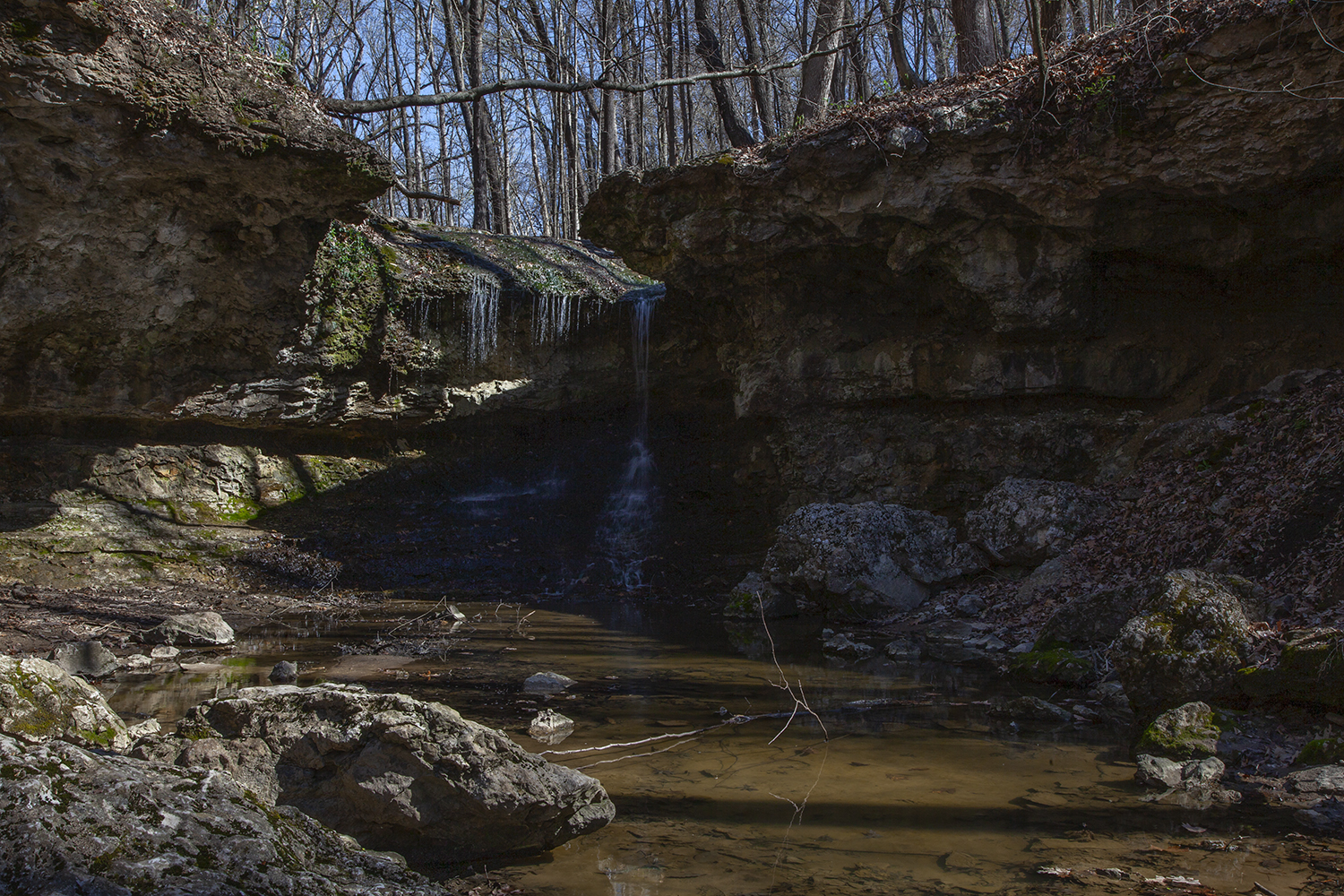
Beaver Falls on the Olin Nature Preserve near Alton, Illinois. (Photo copyright 2019, Chris Madson, all rights reserved)
TWO HUNDRED YARDS TO THE BEND IN THE LANE, ANOTHER 200 DOWN THE HILL AND ACROSS THE PASTURE. AND WE WERE THERE.
In the adult world, it was a 300-acre tract of timber owned by a local industrial magnate who kept a magnificent house of native stone on one edge of the property, but was seldom in residence, being occupied with the business and pleasures of his holdings somewhere far to the east. It was surrounded on three sides by carefully manicured suburban yards and on the fourth by tiny patches of native prairie that clung to the crumbling lip of limestone bluffs 200 feet above the sun-drenched Mississippi. Six or seven miles away, across the expanse of flood plain on the other shore, another set of bluffs rose on the far side of the Missouri, the river itself invisible in the distance as it finished its travels from the wild country to the west.
For the tribe of kids in our neighborhood, it was just “The Woods.”
I don’t know whether my parents were aware of The Woods when they signed the mortgage papers and moved us into the little brick house on the cul de sac. Probably not. Looking back at it with the perspective of a grownup, I’d guess they were taken up with the worries of adults, trying to stretch an anemic budget and climb off the treadmill of rent payments. I imagine the house was what they could afford. The location was just a lucky break— one of the luckiest of my entire life.
A dozen of us grew up in The Woods. Oh, we spent time elsewhere. We helped with chores around the house and went to school and watched TV, but I think it’s fair to say that The Woods were really our home. Everything else lay on the periphery of our lives. We knew the ways in and out almost as well as the deer— the tangle of black raspberry and greenbrier that blocked the northeast corner, the dense second-growth at the head of the creek, the screen of bois d’arc that hid us from Mr. Miller’s kitchen window. Mr. Miller owned the pasture we crossed to get to The Woods, and we were convinced— on the strength of absolutely no evidence— that he frowned on the idea of ragged urchins helping themselves to the shortcut across his land, so when we went, we went like cottontails, quick and quiet as smoke, there for a second, then gone.
In the summer, we left our houses while the dew was still on the grass, sometimes with a packsack of sandwiches, sometimes not. Ten hours later, as the shadows lengthened, we’d emerge, the sweat drying on our faces, thirsty, hungry, generally late for supper.
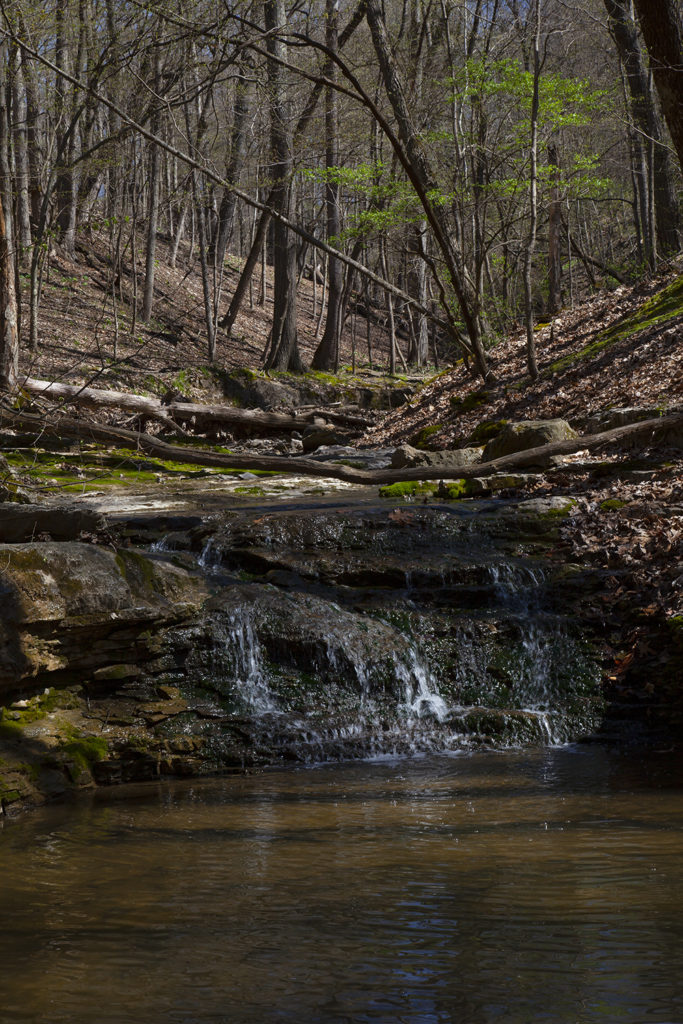
Creek on the Olin Nature Preserve near Alton, Illinois. (Photo copyright 2019, Chris Madson, all rights reserved)
Small as it was, it was an unusually pristine remnant of the forest that had once dominated the Mississippi breaks. A spring-fed creek tumbled over ledges of bedrock, sometimes with a fall of twenty feet, pooling under the shady overhangs where ancient pottery shards bore silent witness to the ghosts of people who had lived in this place long before we arrived. Old-growth white and red oak on the ridges, shagbark and pignut hickory, black cherry, and, down along the creek, walnut and silver maple and giant sycamore, their branches tangled with the vines of wild grape. Carpets of mayapple in the spring, hiding the morels and the occasional jack-in-the-pulpit. Prairie trillium, wild geranium, and ginseng. Sumac and bittersweet at the sunny edges. Shade in the summer, shelter from the north wind in the winter. A world unto itself.
We learned to tell the difference between poison ivy and Virginia creeper there; between stinging nettle and jewel weed; the difference between a squirrel track and a rabbit track, between a hickory and an oak. We saw where raccoons had eaten crawdads and deer had paused to drink.
There were other lessons, too, more subtle, harder to describe, but, in the end, maybe more important: The feel of a gathering storm. The way quiet gathers along the creek with the cool of the evening, touching you almost the way the cool touches you. The sense of discovery. The first heady sensation of being on your own. The taste of freedom.
In January of my seventeenth year, we had a heavy snow. When the wind lay and the sun came out, my mom and dad decided to take my two-year-old sister for a walk. They wrapped her up in coat, mittens and insulated bibs, nested her in a kiddy pack on my dad’s back, and set out for the woods. I grabbed the family toboggan and set off in the other direction to meet friends at the top of a near-vertical slope covered in deadfall and oak timber where we often rendezvoused after a snow to test the extent of our teen-aged invulnerability.
When I walked into the house at dusk, wet and hungry, I could tell an adult discussion had just concluded. Mom was grumbling and Dad was apologetic. He turned to me and, almost as a confession, said: “We got lost down there. I’d never really realized there’s a second drainage that comes in below the falls. We took the wrong creek back. Ended up being a long walk. Good thing we had the little one bundled up.”
Mom hmmphed and went out to the kitchen.
I said nothing, but the thought went through my seventeen-year-old head: How in the world could you get lost down there? And in that instant, I realized two things— that my father was human, and that, in this one tiny slice of life, I knew more than he did.
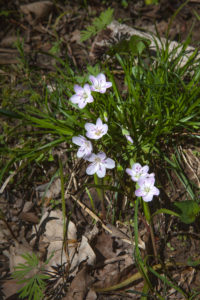
Spring beauty on the Olin Nature Preserve near Alton, Illinois. (Photo copyright 2019, Chris Madson, all rights reserved)
That was fifty years ago. In that time, I’ve found much bigger, wilder places and learned a lot from them, but all those experiences rest on the education The Woods gave me. And, in that, I’m not much different than millions of other people with an interest in wild places. Nearly all the professionals in the field of conservation of wildlife and wild land— biologists, rangers, guides, wildlife photographers, writers— had their own versions of The Woods. For some, it was the creek out back; for others, the draw at the far end of the pasture, a pond, a riverbank, or just some neglected scrap of timber at the edge of a subdivision. Some had adults to get them started; a remarkable number did not.
The same can be said of many others for whom wildlife and wild places are an avocation, not a vocation— birders, wildflower enthusiasts, canoeists, backpackers, hikers, campers, anglers, hunters. For nearly all of us, the beginning can be traced back to a wild place we could call our own.
In recent decades, the conservation community has watched with growing concern as participation in outdoor activities that emphasize wild places has failed to keep pace with the overall growth of population in the United States. Statistics vary, but recent analyses from The Outdoor Foundation provide a sobering overview. In their 2017 report, they found that the proportion of Americans over the age of six who fished has dropped from 19 percent of the population in 2007 to about 16 percent in 2016. The proportion of hunters remained about the same— 5.1 percent in 2007; 5.2 percent in 2016. The proportion of birdwatchers dropped from 4.9 percent to 3.9 percent. The proportion of wildlife viewers dropped from 8.3 percent to 7 percent. Campers— 11.3 percent down to 8.9 percent. Canoeists— 3.5 percent down to 3.4 percent. Backpackers— a small increase from 2.4 percent to 3.4 percent. Hiking— another small increase, from 10.8 percent to 14.2 percent.[i] All this at a time when the nation’s overall population grew by nearly 8 percent.
I suppose those of us who treasure the outdoors can take some faint comfort in the knowledge that competition for access to increasingly scarce resources is waning. Since the quality of most wild experiences decreases as the number of people seeking them increases, these trends will leave better experiences for those of us who remain— at least, for a while. But loss of participants will lead inevitably to a loss of a constituency, which will lead to a drop in funding for wild places and wild things and, even more critical, a decline in the political leverage that has always been crucial in the effort to maintain wildness on the American landscape.
Our wild places need more champions, and for more than twenty years, people who care have tried a variety of approaches to get more people in touch with the wild. It can be argued that the numbers would be even more depressing had it not been for those efforts, but it also seems clear from the statistics that something important is missing in our effort to recruit users— and supporters— of wild land.
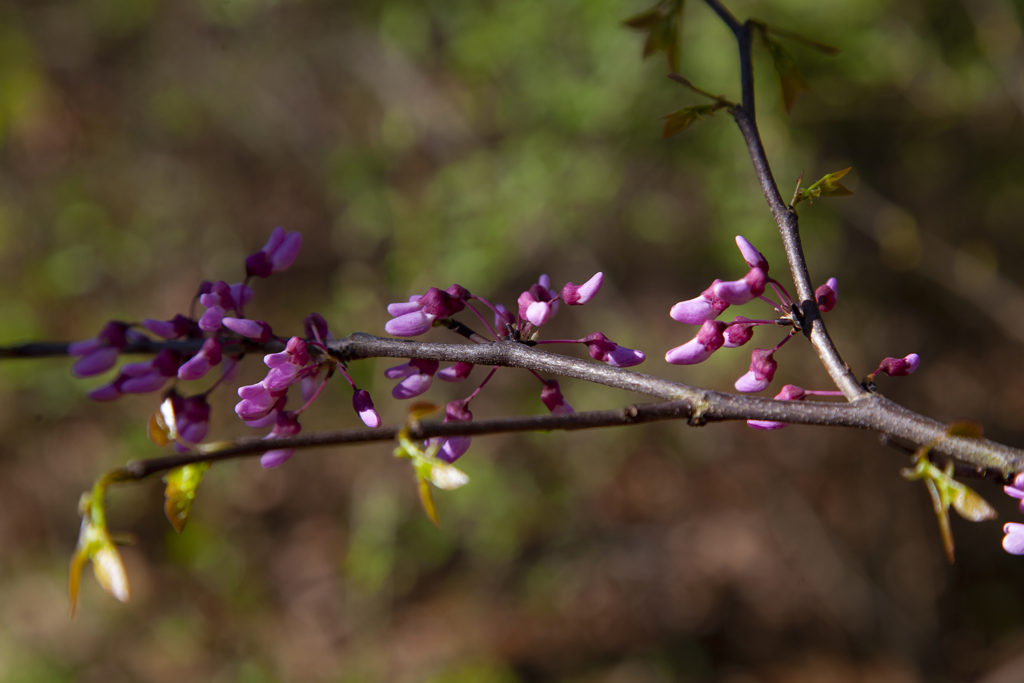
Eastern redbud blossoms near Alton, Illinois. (Photo copyright 2019, Chris Madson, all rights reserved)
I’ve long suspected that one of the missing elements in that effort is the availability of places like The Woods, wild corners that are within biking, or even walking, distance of people who can’t or won’t drive to find them. Places that are not manicured, mowed, trimmed, or pruned, where regulations are kept to a minimum, where a ten- or twelve-year-old can explore without the need for adult transportation or supervision.
A few such places already exist in urban and near-urban settings, some by design, many more by accident, like The Woods. But, as U.S. population grows, such accidents of preservation will happen less and less frequently and are likely to be more and more ephemeral. And, as magnificent as places like New York’s Central Park or Chico, California’s Bidwell Park may be, they’re accessible to only a tiny fraction of local residents who lack motorized transportation.
About four years ago, a team of researchers took a hard look at the growing rift between Americans and the environment, surveying nearly 12,000 people across the country and organizing fifteen focus groups in five of the nation’s biggest cities. The study was led by Dr. Stephen Kellert, a professor of “social ecology” at Yale University and one of the nation’s leading researchers on the relationship between people and their planet. He was assisted by David J. Case and Associates, a firm that has spent most of the last thirty years gathering information on human interactions with the environment.
They published their findings last April in a cooperative report, “The Nature of Americans: Disconnection and Recommendations for Reconnection.”[ii] They found a number of social and economic forces that separated Americans from contact with nature— one of the most telling was the simple lack of wild places close at hand.
“Physical places, or a built environment, generally discourage contact with the natural world,” they wrote in their summary and then continued with the effect of age on that connection: “For children, nature is located quite literally right out the door, and special places outdoors and unforgettable memories often consist of nearby yards, woods, creeks, and gardens. But in contrast to children, adults tend to set a high and even impossible standard for what they perceived to be ‘authentic’ and unforgettable nature, believing that it requires solitude and travel to faraway places, which reinforces their perceptions of the relative inaccessibility of nature. . . . When asked about places near where they live, minorities and urban residents in particular perceive fewer places nearby to enjoy the outdoors.”[iii]
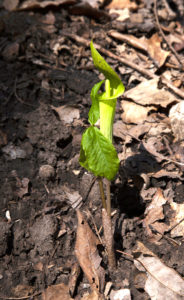
Jack-in-the-pulpit on the Olin Nature Preserve near Alton, Illinois. (Photo copyright 2019, Chris Madson, all rights reserved)
“Nearby”— that’s a part of wild land management that has been largely neglected in the last seventy years. The government agencies that are charged with creating or preserving wild places have limited funds and manpower. They tend to focus on high-quality parcels that are far from town. We have national parks, monuments, forests, grasslands, recreation areas, wild rivers, and wildlife refuges; we have state wildlife reserves and management areas; we have a scattering of wild reserves owned and managed by land trusts and other local entities. Patterns of land use generally dictate that these places are isolated, often hard to reach, even by car, and nearly always far from metropolitan areas. There aren’t enough of them; we need to redouble our efforts to establish them and keep them wild. But they’re not enough.
The task of providing wild playgrounds for most kids may well fall to urban departments of parks and recreation, agencies that are chronically underfunded and often bound by traditional prejudices about what a city park should be. Soccer fields, ball parks, picnic areas, and jungle gyms are all well and good, but in this disconnected age, children need places where they can get back to the earth.
The good news is that such places require almost no maintenance. The bad news is that every neighborhood, every elementary school, needs its own. Too many unsupervised— and we want them to be unsupervised— visitors can wear out a patch of timber or creek bank in short order. Historically, our response to this fact has been to impose regulations, put up signs, assign a police officer, and keep kids out. The enlightened response would be to recognize that we need more wild places, not more rules.
There’s nothing new in this view. Richard Louv should be given credit for resurrecting it in his powerful 2006 book, Last Child in the Woods. “Our society is teaching young people to avoid direct experience in nature,” he wrote. “That lesson is delivered in schools, families, even organizations devoted to the outdoors, and codified into the legal and regulatory structures of many of our communities. Our institutions, urban/suburban design, and cultural attitudes unconsciously associate nature with doom— while disassociating the outdoors with joy and solitude. Well-meaning public-school systems, media, and parents are effectively scaring children straight out of the woods and fields.”[iv]
It was a critically important message, but Louv was far from the first to express concern over the American child’s isolation from the natural world. Gary Nabhan and Stephen Trimble published The Geography of Childhood: Why Children Need Wild Places,[v] a collection of essays on what Louv would later call “nature-deficit disorder,” in 1994. Before Nabhan and Trimble, there was Paul Shepard’s 1982 book, Nature and Madness;[vi] Edith Cobb’s 1959 volume The Ecology of Imagination in Childhood;[vii] Jean Piaget’s 1929 study, The Child’s Conception of the World;[viii] and long before that, Ernest Thompson Seton’s Two Little Savages, first published in 1903. In the introductory chapter of that book, before Seton begins his narrative description of kids building log cabins and tepees, tanning hides, building live traps, foraging for wild fruits and vegetables, hunting and fishing, he offers a thinly-veiled description of his own childhood as the motivation for writing the book:
“His father was in poor circumstances. He was an upright man of refined tastes, but indolent— a failure in business easy with the world and stern with his family. He had never taken an interest in his son’s wildwood pursuits; and when he got the idea that they might interfere with the boy’s education, he forbade them altogether. . . .
“He was a timid, obedient boy in most things, but the unwise command to give up what was in his nature merely made him a disobedient boy— turned a good boy into a bad one. He was too much in terror of his father to disobey openly, but he used to sneak away at all opportunities to the fields and woods, and at each new bird or plant he found he had an exquisite thrill of mingled pleasure and pain— the pain because he had no name for it or means of learning its nature.”
In the dedication of the book, he wrote, “Because I have known the torment of thirst I would dig a well where others may drink.”[ix]
For a century or more, we’ve recognized the crucial need to connect children with the wild world, and yet, we’ve largely failed to provide the single most important and irreplaceable part of that connection: places for children to be wild in.
Here in the United States, we’ve failed to change the way we design urban areas or manage open spaces, and as Richard Louv has written, we’ve done much to deprive our kids of that wild experience, but other countries have begun to experiment with ways to make the connection. In 1993, a group of German educators launched the first forest kindergarten, a pre-school program that was held entirely outdoors. In 2003, there were more than 300 similar preschools in Germany for three- to six-year-old students, popularly known as the “Forest Mice.”[x] In recent years, the concept has spread to the United Kingdom.[xi] The approach has undeniable appeal, and I would love to see America follow suit— the problem is finding the places in our cities and suburbs to hold the classes.
It’s hard to say where the change should begin. Reform of our approach to K-12 education? A more enlightened idea of what urban open space should look like? Parents who have a more realistic view of risk and the importance of independence in a child’s development? All of these things . . . and perhaps something more: an appreciation of the place wildness occupies in the life of every living thing, the human animal not least.
———–
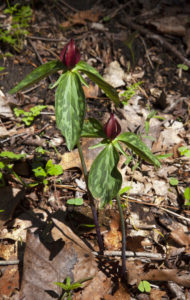
Prairie trillium on the Olin Nature Preserve near Alton, Illinois. (Photo copyright 2019, Chris Madson, all rights reserved)
A couple of weeks ago, my wife and I traveled back to my childhood home for a funeral. We were in need of a little sunshine in the midst of that somber trip, so one chilly April morning, we paid a visit to The Woods. Thanks to the generosity of its former owner, it is now a wildlife reserve, owned and lovingly managed by a local land trust, The Nature Institute, and surrounded by suburbs. We left the car in a parking lot that I remembered as a pasture and took off down a long draw, heading for a waterfall that is the heart of the place.
Maybe it was the unusual point of entry, or maybe it had just been too many years since my last visit— whatever the cause, I turned up the wrong side drainage and soon had us bushwhacking through the timber, making the hike the hard way.
Still, it was worth the walk. Some things we know as children seem to shrink when we come back as adults. This place hadn’t. Sprays of redbud hung over the creek; jack-in-the-pulpit and spring beauty raised their heads from the blanket of last year’s leaves, and the creek shattered as it dropped over the limestone rim, catching the morning sun and throwing it back into the shaded overhangs below.
As I stood there, the lay of the land came slowly back to me, but I had to smile at the memory of that cocksure teen so many years ago, wondering how his dad could ever get lost here. Strange and more than a little sad how hard it can be to find our way back to childhood. But a trip worth making, now and then, for ourselves and our children. Maybe that’s the only way to really understand how much they need the wild.
[i] p.37. Anon, 2017. Outdoor Participation Report 2017. The Outdoor Foundation, Washington, D.C. https://outdoorindustry.org/wp-content/uploads/2017/05/2017-Outdoor-Recreation-Participation-Report_FINAL.pdf. Accessed March 29, 2019.
[ii] Kellert, Stephen R., D.J. Case, Daniel Escher, Daniel J. Witter, Jessica Mikels-Carrasco, and Phil T. Send, 2017. The Nature of Americans: Disconnection and Recommendations for Reconnection. https://natureofamericans.org/. Accessed April 2, 2019.
[iv] p.2. Louv, Richard, 2006. Last Child in the Woods: Saving Our children from Nature-Deficit Disorder. Algonquin Books of Chapel Hill, Chapel Hill, NC.
[v] Nabhan, Gary Paul and Stephen Trimble, 1994. The Geography of Childhood: Why Children Need Wild Places. Beacon Press, Boston, MA.
[vi] Shepard, Paul, 1982. Nature and Madness. Sierra Club Books, San Francisco, CA.
[vii] Cobb, Edith. The Ecology of Imagination in Childhood. Columbia University Press.
[viii] Piaget, Jean, 1929. The Child’s Conception of the World. Redwood Press, Ltd., London, UK.
[ix] Seton, Ernest Thompson, 1903. Two Little Savages: Being the Adventures of Two Boys Who Lived as Indians and What They Learned. Doubleday and Company, Garden City, NY
[x] dePommereau, Isabel, 2003. All outdoors, all the time. Christian Science Monitor, May 13, 2003. https://www.csmonitor.com/2003/0513/p16s01-lecl.html. Accessed April 19, 2019.
[xi] Outdoor kindergarten at Woodland Adventurers. https://www.outdoorkindergarten.org/. Accessed April 19, 2019.
Leave a Reply
You must be logged in to post a comment.